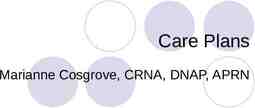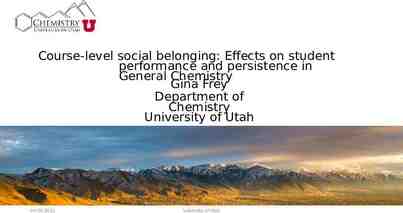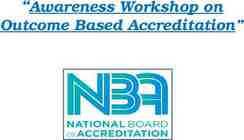Pediatric Anesthesia during the COVID-19 Pandemic May 6, 2020
34 Slides2.55 MB
Pediatric Anesthesia during the COVID-19 Pandemic May 6, 2020
Agenda Welcome and introductions Overview of COVID-19 impact on pediatric anesthesia Overview of preoperative, intraoperative and postoperative management Discussion of strategies for reducing risk for SARS-CoV-2 transmission
Objectives 1) Describe anesthetic management of pediatric patients during the COVID-19 pandemic 2) Describe strategies for reducing the risk of SARSCoV-2 transmission when caring for pediatric patients
Pediatric Anesthesia Speakers James Furstein, PhD, DNAP, CPNP-AC, CRNA Heather J. Rankin, DNP, MBA, CRNA
Input We have reached out to pediatric CRNAs across the nation in large academic facilities, as well as smaller hospitals and surgery centers Most recent data from CDC, NIH, and WHO Research articles pertaining to anesthesia practice during the COVID-19 era
Background Official name for the positive-sense RNA virus responsible for COVID-19 and the disease it causes are: – Disease: coronavirus disease (COVID-19) – Virus: severe acute respiratory syndrome coronavirus 2 (SARS-CoV-2) www.who.int
Background https://www.genetex.com/Research/Overview/infectious diseases/SARS-CoV-2
Background Presenting signs & symptoms: – – – – – – – – – – – Fever Cough Nasal congestion or rhinorrhea Sore throat Shortness of breath Diarrhea Nausea or vomiting Fatigue Headache Myalgia Poor feeding or poor appetite www.cdc.gov
Background Cytokine storm syndrome Disease progression: – – – – ARDS Respiratory failure Shock Multi-organ dysfunction: Lungs Liver Kidney www.cdc.gov www.anesthesiologynews.com
Epidemiology Data as of 05.04.20 https://
Epidemiology Data as of 05.04.20 https://
Epidemiology World-Wide Impact: – In the United States, 2% of confirmed cases of COVID-19 were among persons aged 18 years. – In China, 2.2% of confirmed cases of COVID-19 were among persons aged 19 years old. – In Italy, 1.2% of COVID-19 cases were among children aged 18 years. – In Spain, 0.8% of confirmed cases of COVID-19 were among persons aged 18 years. – Reported median age is 7 years old (Leboulangera, et. al, 2020) https://www.sciencedirect.com/science/article/pii/S1879729620301009 www.cdc.gov
Patient Testing Strategies Widely varies between institutions – Testing all peds before coming to the OR so they can save their PPE for positive patients only – Treating every patient as positive – Testing all inpatients – Testing ENT, bronchs, GI, and dental
Healthcare Provider Testing Healthcare providers asked to stay home if displaying any symptoms Seeking testing if symptomatic Quarantined if out of country, and in some institutions, out of state
Pharmacologic Management https://near4kids.research.chop.edu
Anesthetic Recommendations Administer anxiolytic medications Perform IV inductions Use video laryngoscopes and cuffed ETTs Examine and modify if needed PACU Negative pressure rooms for known cases or for high risk procedures Proper PPE https://journals.lww.com/anesthesia-analgesia/Abstract/publishahead/Pediatric Airway Management in COVID 19 patients .9 5683.aspx
Preoperative Management Prepare all drugs and medications in advance Consider the use of premedication to reduce crying and aerosol generation – Avoid nasal administration Avoid parental presence at induction Consensus Guidelines from the Society for Pediatric Anesthesia’s Pediatric Difficult Intubation Collaborative and the Canadian Pediatric Anesthesia Society, Anesthesia & Analgesia: April 13,
Intraoperative Management Ensure adequate air exchange – Negative pressure rooms for aerosol-generating procedures If negative pressure room not available use HEPA filter Induction: – Intravenous induction preferred Neuromuscular blockade drug recommended Consider rapid sequence induction – Caution with bag mask ventilation if necessary – Mask induction (if required) Use lowest possible flows Consider clear plastic barrier Consensus Guidelines from the Society for Pediatric Anesthesia’s Pediatric Difficult Intubation Collaborative and the Canadian Pediatric Anesthesia Society, Anesthesia & Analgesia: April 13,
Intraoperative Management Airway Securement: – Preferred: Cuffed ETT Video laryngoscopy Most experienced laryngoscopist In-line closed suctioning – Acceptable: LMA with good seal Simple face mask may reduce aerosol dispersion – Least Desirable: Nasal cannula, bag mask ventilation Avoid clinician exposure with leak checks (use equipment instead) Consensus Guidelines from the Society for Pediatric Anesthesia’s Pediatric Difficult Intubation Collaborative and the Canadian Pediatric Anesthesia Society, Anesthesia & Analgesia: April 13,
Intraoperative Management Difficult Airway: – Most experienced laryngoscopist 1st: Videolaryngoscopy 2nd: Fiberoptic through LMA 3rd: Combined fiberoptic with video laryngoscopy 4th: Consider an invasive airway – Consider neuromuscular blocking agent – If bag mask ventilation unavoidable, use low tidal volumes with two-person technique – Avoid passive oxygenation if tolerated Consensus Guidelines from the Society for Pediatric Anesthesia’s Pediatric Difficult Intubation Collaborative and the Canadian Pediatric Anesthesia Society, Anesthesia & Analgesia: April 13,
Intraoperative Management Emergence: – – – – – In-line closed suctioning preferred Clear plastic barrier in place Recover in the operating room Consider deep extubation Minimize coughing TIVA, dexmedetomidine, propofol, lidocaine, etc. Consensus Guidelines from the Society for Pediatric Anesthesia’s Pediatric Difficult Intubation Collaborative and the Canadian Pediatric Anesthesia Society, Anesthesia & Analgesia: April 13,
Postoperative Management PACU – Avoid common close areas when possible – Distancing – N95 for PACU staff when aerosolizing treatments are given – Decreased use of blow by O2 when appropriate – Negative pressure rooms utilized for high risk cases
Postoperative Management Transporting Intubated Patients: – Viral filters on patient side and expiratory limb of ventilators – Viral filter between endotracheal tube adapter and manual transport circuit – Consider optimizing sedation and/or neuromuscular blockade Consensus Guidelines from the Society for Pediatric Anesthesia’s Pediatric Difficult Intubation Collaborative and the Canadian Pediatric Anesthesia Society, Anesthesia & Analgesia: April 13,
PPE N95 or PAPR Paper bags and UV utilization Rotation of masks Gowns, gloves, goggles/face shields AANA joint position statement https://www.aana.com/home/aana-updates/2020/03/20/aana-asa-and-apsf-issue-joint-statement-on-use-of-personal-prot ective-equipment-during-covid-19-pandemic
Aerosol-Generating Procedures Aerosol-Generating Procedure Odds Ratio Tracheal intubation 6.6 Tracheostomy 4.2 Suction before intubation 3.5 Non-invasive ventilation 3.1 Manual ventilation before intubation 2.8 Chest compression/defibrillation 2.5 Bronchoscopy 1.9 Consensus Guidelines from the Society for Pediatric Anesthesia’s Pediatric Difficult Intubation Collaborative and the Canadian Pediatric Anesthesia Society, Anesthesia & Analgesia: April 13,
Common Cases: ENT Otolaryngologists recommended all elective cases on hold with case by case criteria examined at the end of March, update in April Now seeing increase in ENT cases If no testing performed preoperatively, treat as , esp with nasal procedures Consider recovering in the OR, especially if aerosolizing treatments are suspected Testing 48 hours prior to procedure – high false negatives Procedure done by experienced senior surgeon
Common Cases: Dental Nasal vs oral intubations – Nasal viral load is higher Aerosolization concerns PPE for everyone in the room
Common Cases Endoscopies Laparoscopic procedures
Mental Health Wall of kindness Many places not doing much Good feedback from clinicians who want to make something happen in this area Local restaurants and businesses have been supportive AANA website resources Daily or weekly emails from facility https://www.aana.com/aana-covid-19-resources/covid-19-well-being
Q&A
Questions or Comments [email protected] Resources The American Academy of Pediatrics Interim Guidance for Healthcare Providers Caring for Pe diatric Patients .
References https://www.CDC.gov https://covid19treatmentguidelines.nih.gov/tables/table-2b/ https://www.who.int/emergencies/diseases/novel-coronavirus-2019 https://www.anesthesiologynews.com/Online-First/Article/04-20/COVID-19-Brings-Cytokine-S torm https://www.cdc.gov/coronavirus/2019-ncov/hcp/pediatric-hcp.html https://covid19treatmentguidelines.nih.gov/overview/children/ https://www.myvps.org
References https://near4kids.research.chop.edu https://www.aana.com/home/aana-updates/2020/03/20/aana-asa-and-apsf-issue-joint-state ment-on-use-of-personal-protective-equipment-during-covid-19-pandemic Leboulanger N, Sagardoy T, Akkari M, Ayari-Khalfallah S, Celerier C, Fayoux P, Luscan R, Mansbach AL, Moreddu E, Pondaven S, Simon F, Teissier N, Thierry B, Fanoux A, Lescanne E, Nicollas R, Couloigner V, SARS-CoV-2 et ORL p ediatrique en contexte de pand emie a SARSCoV-2 (COVID-19), Annales franc aisesd oto-rhino-laryngologie et de pathologie cervicofaciale (2020),doi: https://doi.org/10.1016/j.aforl.2020.04.006
References Mallick, R., Odejinmi, F., Clark, T.J. (2020). Covid 19 pandemic and gynaecological laparoscopic surgery: knowns and unknowns. Facts Views Vis OBGYN. https://www.ncbi.nlm.nih.gov/pmc/articles/PMC7117791/ Soetikno R, Teoh AY, Kaltenbach T, Lau JY, Asokkumar R, CabralProdigalidad P, Shergill A, Considerations in performing endoscopy during the COVID-19 pandemic, Gastrointestinal Endoscopy (2020), doi: https://doi.org/10.1016/j.gie.2020.03.3758. Vukkadala, N., Qian, Z.Q., Holsinger, F.C., Patel, A.M., Rosenthal, E. (2020). COVID-19 and the Otolaryngologist: Preliminary Evidence-Based Review. The Laryngoscope. https://onlinelibrary.wiley.com/doi/epdf/10.1002/lary.28672







































